前景实用英语 教案 Unit 3 Learning
- 格式:doc
- 大小:35.00 KB
- 文档页数:3
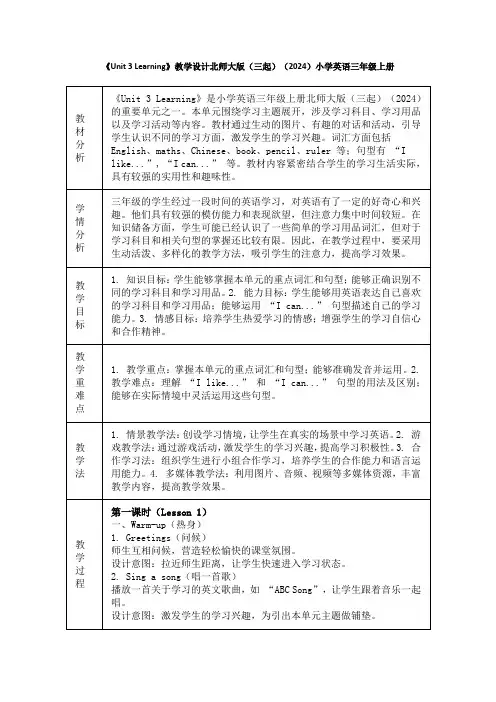

教案首页2021-2021 学年第一学期专业:课程名称:高职英语班级:主讲教师:Unit 1 CollegePeriod 1-2Part A Lead-in and Text ATeaching aims:1.Help freshmen get familiar with the studies and lives in college and discuss about it;2.Master the useful words and expressions in Text A;Teaching important points:1. Ss. Learn some new words and use them in the discussion2.New words and expressions in Text ATeaching difficult points:Ss. Learn how to talk about college lifeTeaching steps:Step 1Greetings and a brief introduction of English learning scheduleStep 2 Lead-in1.Warm-up questions:Do you like your college life? What differences are there between college and high school life?2.Study the pictures on page 2 and discuss the questions below in small groups.1)Who are the people in each picture? What’s their relationship?Cues: students, classmates, sports friends2)Where are they? What are they doing?Cues: classroom, football field, library, listening, playing, looking for3)Do you think they enjoy what they are doing now?Cues: very much so, not at allStep 3 SpeakingReview the sentences drills about greeting and introduction; let some pairs practice them Step 4 Listening1.Read the instruction as a class.2.Play the recording twice, and check Ss’Exs. and repeat some sentences ifnecessaryanize a class discussion based on this task. Then ask Ss. to think aboutmethods to improve their English listening skills.Step 5 Text A1.Ss. learn some words and phases from vocabulary2.Lead-in1)Warm-up questions.e.g. Do you think Chinese college life is very different from western one?2) A brief introduction of American college life to arouse Ss’ interest3.ScanningAsk Ss. read the Text very quickly and get the main idea.4.Ss. finish the Task 1 and then check the answersStep 6 H.WFinish Task 2-4 on page 10-12Period 3-4Text A :The Freshman Experiences: College is not summer camp Teaching aims:1. understand the passage pletely;2. master the key words, expressions & sentence patterns in Text ATeaching important points:1. the structure of the Text A2. New words and expressions in Text ATeaching difficult points:understand the passage pletelyTeaching steps:Step 1 GreetingStep 2 Revision and Check the answers from Task 2-4Step 3 scanningSs. read the text again and find some difficult sentences to ask for help ;Teachers and Ss. solve these difficulties togetherStep 4 Intensive readingList some language points –some important words and difficult sentences1. imaginev. to form a picture in your mind of what something might bee.g. She imagined singing her favorite song on a big stage.她想象着自己在一个巨大的舞台上唱自己最喜欢的歌曲。
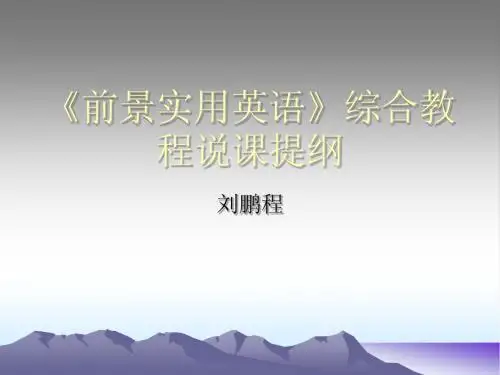

前景实用英语(二)-unit3教案三亚航空旅游职业学院教案编号Unit 3 Knowledge and SkillsTeaching aims:In this unit, students are supposed to▪know how to talk about learning in daily life;▪master the basic language to express reassuring and persuading;▪understand the main idea of Text A, and master the useful sentence structures and words and expressions;▪master the phonetic skill: assimilation;▪know substantive clause;▪know how to write “A Postcard”.Teaching procedures:I Listening and Speaking (2Period)II Text A & text-related exercises (2Period)III Workbook & text-related exercises (2Period)IV Grammar Review and Practical Writing (2Period)Part A Lead inTask 1 Study the pictures and discuss the questions below in small groups. Use the words given below if necessary.1.What are the people in the first picture doing?Cues: basketball, training, trainer, trainee2.How do you understand the words in the second picture? Do you knowthe Chinese for it ?Cues: the more ... the better ..., practice, learn, well3.What is “stage fright”?Cues: fear, anxiety, public, audience, sweaty handsTask 2 Listen to the following short dialogues and fill in the blanks.Task 3 Discuss the following questions.1. How can we learn a skill?Cues: knowledge, practice, familiar, second nature2.Have you ever had any experience of stage fright? If yes, please share onewith the class.Cues: knowledge, practice, familiar, second naturePart B Text ALearning Knowledge and Skill: PracticeLanguage points:Leakya. having holes or cracks that allow liquid or gas to escapee.g. Water came from the leaky roof.水从屋顶漏下来。
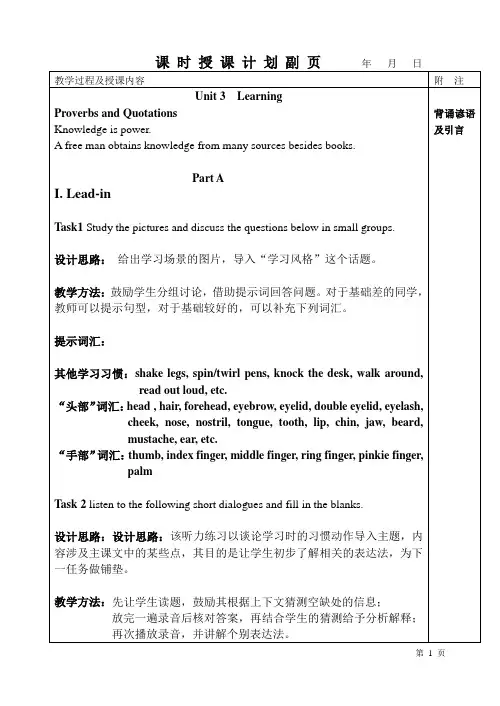


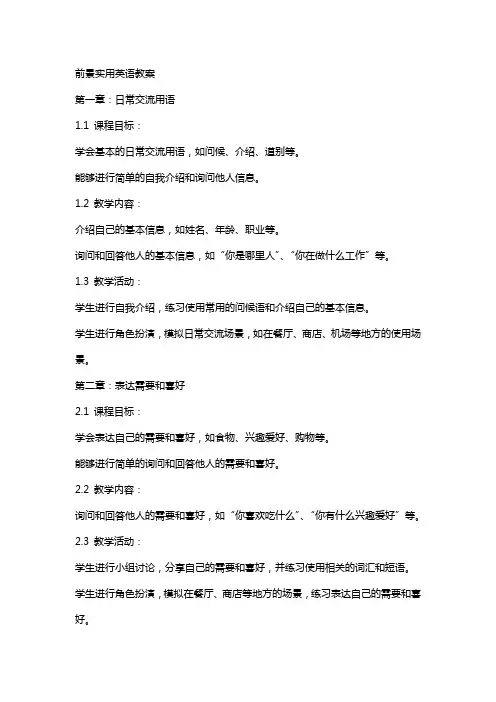
前景实用英语教案第一章:日常交流用语1.1 课程目标:学会基本的日常交流用语,如问候、介绍、道别等。
能够进行简单的自我介绍和询问他人信息。
1.2 教学内容:介绍自己的基本信息,如姓名、年龄、职业等。
询问和回答他人的基本信息,如“你是哪里人”、“你在做什么工作”等。
1.3 教学活动:学生进行自我介绍,练习使用常用的问候语和介绍自己的基本信息。
学生进行角色扮演,模拟日常交流场景,如在餐厅、商店、机场等地方的使用场景。
第二章:表达需要和喜好2.1 课程目标:学会表达自己的需要和喜好,如食物、兴趣爱好、购物等。
能够进行简单的询问和回答他人的需要和喜好。
2.2 教学内容:询问和回答他人的需要和喜好,如“你喜欢吃什么”、“你有什么兴趣爱好”等。
2.3 教学活动:学生进行小组讨论,分享自己的需要和喜好,并练习使用相关的词汇和短语。
学生进行角色扮演,模拟在餐厅、商店等地方的场景,练习表达自己的需要和喜好。
第三章:询问方向和地点3.1 课程目标:学会询问方向和地点,如问路、找到某个地方等。
能够准确地表达自己的位置和方向。
3.2 教学内容:常用的询问方向和地点的词汇和短语,如“请问在哪里”、“怎么走”等。
表达自己的位置和方向,如“我在超市的旁边”、“你往前走,左转”等。
3.3 教学活动:学生进行角色扮演,模拟在街头问路的情景,练习使用相关的词汇和短语。
学生进行小组活动,制作简单的地图,练习表达自己的位置和方向。
第四章:描述人和事物4.1 课程目标:学会描述人和事物的特征和属性,如外貌、性格、喜好等。
能够准确地表达自己的观察和看法。
4.2 教学内容:常用的描述人和事物的词汇和短语,如“高个子”、“善良的”、“喜欢音乐”等。
表达自己的观察和看法,如“我觉得他很聪明”、“她看起来很累”等。
4.3 教学活动:学生进行小组讨论,描述自己或他人的外貌和性格特点,并练习使用相关的词汇和短语。
学生进行角色扮演,模拟在面试或相亲等场合描述自己和对方的特征和属性。
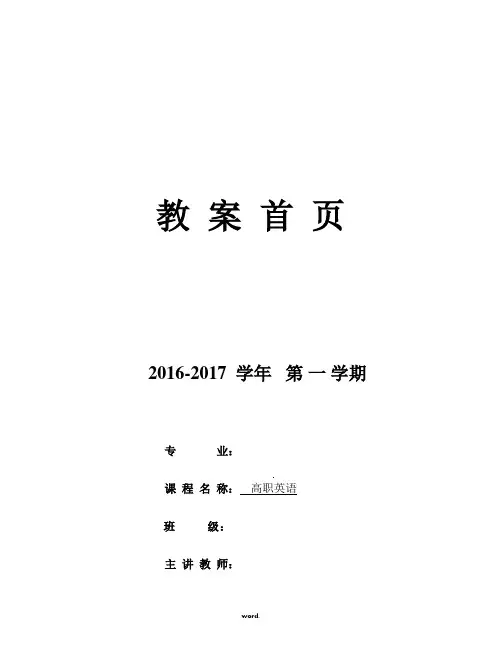
教案首页2016-2017 学年第一学期专业:课程名称:高职英语班级:主讲教师:Unit 1 CollegePeriod 1-2Part A Lead-in and Text ATeaching aims:Help freshmen get familiar with the studies and lives in college and discuss about it;Master the useful words and expressions in Text A;Teaching important points:1. Ss. Learn some new words and use them in the discussion2.New words and expressions in Text ATeaching difficult points:Ss. Learn how to talk about college lifeTeaching steps:Step 1Greetings and a brief introduction of English learning scheduleStep 2 Lead-in1.Warm-up questions:Do you like your college life? What differences are there between college and high school life?Study the pictures on page 2 and discuss the questions below in small groups.Who are the people in each picture? What’s their relatio nship?Cues: students, classmates, sports friends2)Where are they? What are they doing?Cues: classroom, football field, library, listening, playing, looking forDo you think they enjoy what they are doing now?Cues: very much so, not at allStep 3 SpeakingReview the sentences drills about greeting and introduction; let some pairs practice themStep 4 Listening1.Read the instruction as a class.Play the recording twice, and check Ss’Exs. and repeat some sentences if necessaryOrganize a class discussion based on this task. Then ask Ss. to think about methods to improve their English listening skills.Step 5 Text ASs. learn some words and phases from vocabulary2.Lead-in1)Warm-up questions.e.g. Do you think Chinese college life is very different from western one?A brief introduction of American college life to arouse Ss’ interest3.ScanningAsk Ss. read the Text very quickly and get the main idea.Ss. finish the Task 1 and then check the answersStep 6 H.WFinish Task 2-4 on page 10-12Period 3-4Text A :The Freshman Experiences: College is not summer campTeaching aims:1. understand the passage completely;2. master the key words, expressions & sentence patterns in Text ATeaching important points:1. the structure of the Text A2. New words and expressions in Text ATeaching difficult points:understand the passage completelyTeaching steps:Step 1 GreetingStep 2 Revision and Check the answers from Task 2-4Step 3 scanningSs. read the text again and find some difficult sentences to ask for help ;Teachers and Ss. solve these difficulties togetherStep 4 Intensive readingList some language points –some important words and difficult sentences1. imaginev. to form a picture in your mind of what something might bee.g. She imagined singing her favorite song on a big stage.她想象着自己在一个巨大的舞台上唱自己最喜欢的歌曲。
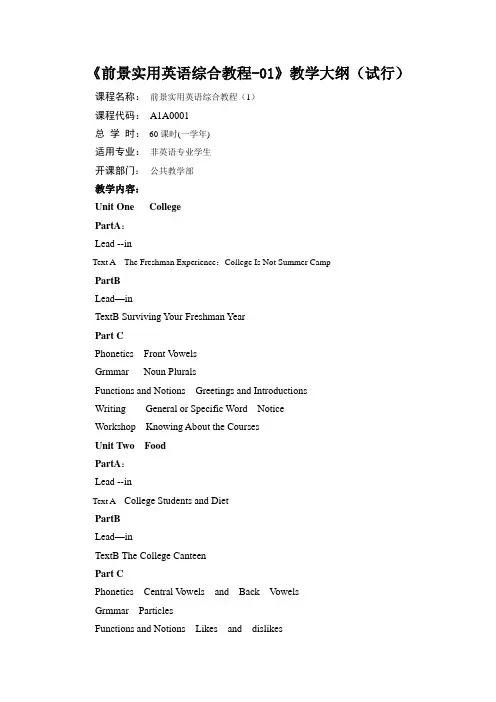
《前景实用英语综合教程-01》教学大纲(试行)课程名称:前景实用英语综合教程(1)课程代码:A1A0001总学时:60课时(一学年)适用专业:非英语专业学生开课部门:公共教学部教学内容:Unit One CollegePartA:Lead --inText A The Freshman Experience:College Is Not Summer CampPartBLead—inTextB Surviving Your Freshman YearPart CPhonetics Front V owelsGrmmar Noun PluralsFunctions and Notions Greetings and IntroductionsWriting General or Specific Word NoticeWorkshop Knowing About the CoursesUnit Two FoodPartA:Lead --inText A College Students and DietPartBLead—inTextB The College CanteenPart CPhonetics Central V owels and Back V owelsGrmmar ParticlesFunctions and Notions Likes and dislikesWriting Effective Sentences MenuWorkshop Finding Food on CampusUnit Three LearningPartALead-inText A What’s Your Learning Style?Part BLead --inText B The SQ3R MethodPart CPhonetics Rising DiphthongsGrmmar Modal AuxiliariesFunctions and Notions Making and Asking for Suggestions Writing Coordination and Subordination Invitation Card Workshop Knowing About Your Best Learning StyleUnit Four SportsPartALead-inText A Why Play College Sports ?Part BLead --inText B One Month Challenge :Fun with FitnessPart CPhonetics Centering DiphthongsGrmmar Pronouns IFunctions and Notions InvitationsWriting Developing Paragraphs by Examples Business Card Workshop Survey About Your Best Learning StyleUnit Five Digital AgeLead-inText A Can College StudentsLearn as Well as on Ipads?Part BLead --inText B The Web Way to Leran a LanguagePart CPhonetics Stop ConsonantsGrmmar PreositionsFunctions and Notions Agreening and DisagreeingWriting Develpoing Paragraphs by Comparision and Contrast Email Workshop Survey by Using Internet ToolsUnit Six EnvironmentLead-inText A How College Can Go Green on CampusPart BLead --inText B Going Green on Camps :An Inspired Student Working to Inspire Others Part CPhonetics Affricate ConsonantsGrmmar Comparative StructuresFunctions and Notions Worries Concerns and SympathyWriting Develpoing Paragraphs by Classification EnvelopeWorkshop Promote the Idea of Green CampusUnit Seven Fashion and BeautyLead-inText A Understanding Human BeautyPart BLead --inText B College Students Are Seeking Out Plastic SurgeryPart CPhonetics Nasal ConsonantsGrmmar TenseFunctions and Notions Satisfaction and DissatisfactionWriting Develpoing Paragraphs by Definition CardsWorkshop Presentation for the Text “Understanding Human Beauty”Unit Eight CareerLead-inText A Different College Experiences and Different Job OpportunitiesPart BLead --inText B Prepare for Your Career at CollegePart CPhonetics Lateral Consonants and Semi V owelsGrmmar Sentence TypesFunctions and Notions Intentions and PlansWriting Developing Paragraphs by Cause and Effect AdvertisementsWorkshop Roleplay a Job Interview教学大纲说明一、课程的性质与任务1、课程的性质实用英语课程是为我校非英语专业学生第一学年开设的公共基础课,是各个专业的专业英语课程的基础,也是培养学生人文素质的一门必修课程。
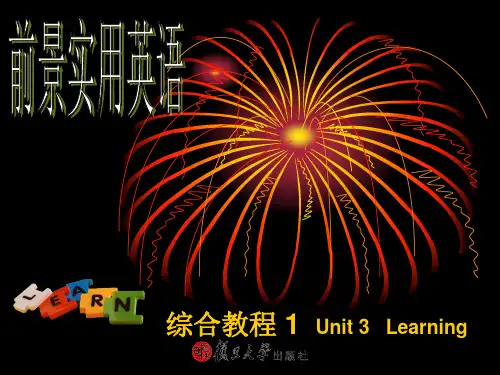
Unit 3 Food and CulturePeriod 2 Learning About Language(导学案)2024年课程标准学习目标本单元的单元主题语境是Food andCulture,该课时是其语法项目教学:The Past Perfect Tense。
语法是指导人们正确使用语言的行动准则,它来自于活生生的语言,并运用于语言的交际活动,对一个语法项目的真正掌握应体现在对语言形式、语义和语用三方面的活用上。
【语言能力】总结过去完成时的定义和公式及用法。
【思维品质】培养识别和使用过去完成时的能力。
【文化意识】在给定的情境中培养逻辑思维和创造性思维的能力。
【观察例句】1.When my family and I had just arrived in China,we went looking for a good place to eat in Beijing. 2.Tired,hungry,and not knowing a word of Chinese,we had no idea how to order,so the chef just began filling our table with the best food we had ever eaten.3.A Sichuan restaurant had been remended to us by a friend,and finally,we found it.4.Prior to ing to China,my only experience with Chinese cooking was in America,with Chinese food that had been changed to suit American tastes.【归纳用法】1.例句1和2的黑体部分为过去完成时,其构成为“had+动词过去分词”,表示过去某一时间或动作以前已经发生或完成了的动作。
Unit 3 Learning1. Topic: Learning2. Teaching objectives:After the class, the students will be able to1) Know the different styles of learning2) Provide multiple opportunities for the students to practice interactive speaking and listening.3) Focus on the correct pronunciation and intonation.4) Master the key words and structures.3. Difficulties and keys:1) V ocabulary: (omitted)2) Speaking: Making and Asking for suggestion3) Grammar: Model verbs4) Practical writing: How to write an invitation4. Teaching Aids:(1) Blackboard,(2) Multimedia system,(3) PPT6. Time Allotment:(1)Lead in and New Words (30mins) (2) Analysis of the Text (90mins)(3) Exercises (90mins) (4) Grammar Tips and Writing (60mins)(5) Listening (60mins)7. Teaching methods and strategies(1)Practice speaking and listening(2)Discussion(3)Presentation and role play(4) Exercises8. Teaching ProcessPeriod 1:Step 1. Lead-in (5 minutes)Study the pictures and discuss the questions below in small groups..Question:1. where are those people in the two pictures on the left?2. Do you listen to MP3 or put a pen or a pencil in your mouth while you are studying?3. Are pictures helpful to you in memorizing English words?Hint:Step 2. Listening exercise (10 minutes)Step 3. Vocabulary in Text A (20 minutes)Ask Ss to read new words and expressions by themselves and then read the new words together. Explain the important points.1. unique a. being the only one of its kinde.g. Everyone’s fingerprints are unique..2. in general : usually; as a wholee.g. In general, an English dictionary starts with the letter A.3. visual a. of or gained by seeing or sight.e.g. The teaching building makes a tremendous visual impact.Step 4. Vocabulary Check Task 3&4 (10 minutes)Ask the students to finish the exercise, vocabulary check (part B and C). Then check the answers.Period 2:Step 1. Language Points in Text A (30 minutes)Explain the language points to Ss and analyze the structure of the passage. Pay more attention to longer sentences in Text A and try to make Ss understand.Kinaesthetic learners can have…especially past elementary age:Because traditional schools pay less attention to kinaesthetic learners than to auditory and visual learners, kinaesthetic learners can have the most difficulty in their learning, especially when they finish elementary school and grow older.Step 2. Comprehension of Text A (15 minutes)Give students 5 minutes to go through the text, ask them to finish the exercise then check the answers.Period 3:Step 1. Comprehensive Exercises (45 minutes)Ask the students to finish the exercise then check the answers.Period 4:Step 1. Phonetics (20 minutes)Ask the students to pay more attention to the Rising Diphthongs and then do some listening and speaking.Step 2. Grammar Tips 情态动词( Model Verb) (20 minutes)First, ask Ss to preview the explanation and then give further study of the grammar tip. Do the exercises to check out whether Ss know the grammar well.Period 5&6: Practical Writing (How to Write an Invitation)It is necessary to teach some writing skills beforehand, and then study the sample. Ask Ss to write a note on the spot.Step 1. General Introduction (10 minutes)Step 2. Sentence patterns for Invitation (15 minutes):Introduce some useful sentence patterns to help students understand how to write a thanks note.1...would be delighted for you to join them.2...request the honor of your presence…3. …would like to invite you to …Step 3. In-class Activities (20 minutes)This section contains short dialogues that making and asking for suggestions in campus.Step 4. Speaking Out (10 minutes)This part is designed for students using certain expressions to ask for suggestions. Period 7&8:Step 1. Culture Notes (15 minutes)Let the students read this section on their own. The teacher may want to check if they have read this section by asking the following questions:Step 2. After-class Activities (30 minutes)Although the exercises included in this part are meant for the students to practice in their spare time, the teacher may want to select some of them to practice in class, especially those in Sections A and B. Unlike those in Book One, the exercise items included in Section B are mini-dialogues designed to prepare the students for the standardized examination they are to take in the following year.9. Text review and consolidation(5min)(1) Key words of each para.(2) Important Phrases10. Homework Assignment(2min)(1) Words and expression study(2) Finishing the exercises of the text11. Questions from/Discussions with the students(5min)12. Reflection of the class teaching:(1) Have key points every class and dictate in next, and give students press to study.(2) Try to go more opportunities for the poor-level students.。
Unit 3 Learning1. Topic: Learning2. Teaching objectives:After the class, the students will be able to1) Know the different styles of learning2) Provide multiple opportunities for the students to practice interactive speaking and listening.3) Focus on the correct pronunciation and intonation.4) Master the key words and structures.3. Difficulties and keys:1) V ocabulary: (omitted)2) Speaking: Making and Asking for suggestion3) Grammar: Model verbs4) Practical writing: How to write an invitation4. Teaching Aids:(1) Blackboard,(2) Multimedia system,(3) PPT6. Time Allotment:(1)Lead in and New Words (30mins) (2) Analysis of the Text (90mins)(3) Exercises (90mins) (4) Grammar Tips and Writing (60mins)(5) Listening (60mins)7. Teaching methods and strategies(1)Practice speaking and listening(2)Discussion(3)Presentation and role play(4) Exercises8. Teaching ProcessPeriod 1:Step 1. Lead-in (5 minutes)Study the pictures and discuss the questions below in small groups..Question:1. where are those people in the two pictures on the left?2. Do you listen to MP3 or put a pen or a pencil in your mouth while you are studying?3. Are pictures helpful to you in memorizing English words?Hint:Step 2. Listening exercise (10 minutes)Step 3. Vocabulary in Text A (20 minutes)Ask Ss to read new words and expressions by themselves and then read the new words together. Explain the important points.1. unique a. being the only one of its kinde.g. Everyone’s fingerprints are unique..2. in general : usually; as a wholee.g. In general, an English dictionary starts with the letter A.3. visual a. of or gained by seeing or sight.e.g. The teaching building makes a tremendous visual impact.Step 4. Vocabulary Check Task 3&4 (10 minutes)Ask the students to finish the exercise, vocabulary check (part B and C). Then check the answers.Period 2:Step 1. Language Points in Text A (30 minutes)Explain the language points to Ss and analyze the structure of the passage. Pay more attention to longer sentences in Text A and try to make Ss understand.Kinaesthetic learners can have…especially past elementary age:Because traditional schools pay less attention to kinaesthetic learners than to auditory and visual learners, kinaesthetic learners can have the most difficulty in their learning, especially when they finish elementary school and grow older.Step 2. Comprehension of Text A (15 minutes)Give students 5 minutes to go through the text, ask them to finish the exercise then check the answers.Period 3:Step 1. Comprehensive Exercises (45 minutes)Ask the students to finish the exercise then check the answers.Period 4:Step 1. Phonetics (20 minutes)Ask the students to pay more attention to the Rising Diphthongs and then do some listening and speaking.Step 2. Grammar Tips 情态动词( Model Verb) (20 minutes)First, ask Ss to preview the explanation and then give further study of the grammar tip. Do the exercises to check out whether Ss know the grammar well.Period 5&6: Practical Writing (How to Write an Invitation)It is necessary to teach some writing skills beforehand, and then study the sample. Ask Ss to write a note on the spot.Step 1. General Introduction (10 minutes)Step 2. Sentence patterns for Invitation (15 minutes):Introduce some useful sentence patterns to help students understand how to write a thanks note.1...would be delighted for you to join them.2...request the honor of your presence…3. …would like to invite you to …Step 3. In-class Activities (20 minutes)This section contains short dialogues that making and asking for suggestions in campus.Step 4. Speaking Out (10 minutes)This part is designed for students using certain expressions to ask for suggestions. Period 7&8:Step 1. Culture Notes (15 minutes)Let the students read this section on their own. The teacher may want to check if they have read this section by asking the following questions:Step 2. After-class Activities (30 minutes)Although the exercises included in this part are meant for the students to practice in their spare time, the teacher may want to select some of them to practice in class, especially those in Sections A and B. Unlike those in Book One, the exercise items included in Section B are mini-dialogues designed to prepare the students for the standardized examination they are to take in the following year.9. Text review and consolidation(5min)(1) Key words of each para.(2) Important Phrases10. Homework Assignment(2min)(1) Words and expression study(2) Finishing the exercises of the text11. Questions from/Discussions with the students(5min)12. Reflection of the class teaching:(1) Have key points every class and dictate in next, and give students press to study.(2) Try to go more opportunities for the poor-level students.。